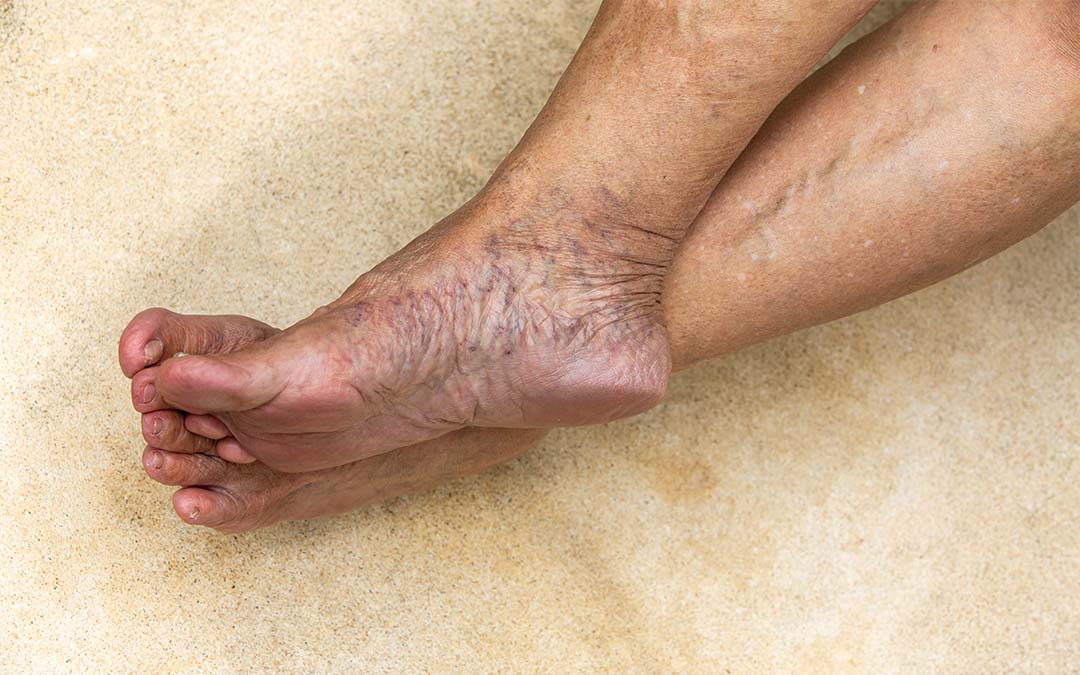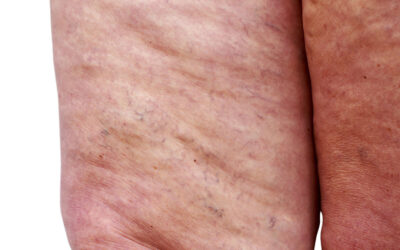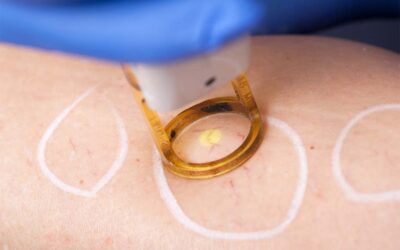The bluish veins that show up close to the surface of the skin on the inner or outer ankles and feet may have been there a while, and perhaps you feel a little unsure if they’re a problem. What are they? What causes them? Are they good, bad, or indifferent? Corona phlebectasia are the spider veins that can appear near the ankle and foot. They fan out like the sun’s corona, hence the name – and are larger than healthy capillaries. Essentially, these veins aren’t working as they should and may indicate venous disease.
Are spider veins in the feet and ankles a reason for concern?
Many of us have abnormal veins that show up over time. Their symptoms can give us a good indication as to what action we should take.
With ankle and foot varicose veins or spider veins, there are several experiences you may notice. Some people just get the veins on their ankle exclusively and notice no other pain or sign of a problem. Others will see the foot veins, but also feel pain in the leg, swelling, itching, or if these veins are an indication of more advanced venous disease, they might even have some skin breakdown or eczema or ulcers on the skin surface. Just to be thorough, I also want to mention the varicose veins you can’t see. In this case, you might have pain in the ankle, foot, and lower leg, but not really see any abnormal veins on the surface of the skin. You might feel the symptoms of varicose veins, but not see them.
We use the term spider vein when talking about small veins, fine in appearance. Many people don’t consider them an actual health problem, they may just wish their skin looked better. But they’re a sign of an overflow of blood from a varicose vein. You might be able to see the varicose vein, or it might be located deeper under the skin. When a vein stops functioning properly, it stops allowing efficient blood flow in one direction and has a backflow of blood. When this builds up, the excess blood makes its way into other smaller adjacent veins or capillaries. That’s when you’ll see spider veins. So, while spider veins on the legs, ankles, and feet are not a big drama in themselves, they can be an indicator that there’s something else afoot, and your other veins might be causing you problems where you hadn’t made the connection.
In short, get them checked by a phlebologist (a vein doctor). You don’t know what’s going on in your veins until you get an ultrasound to ascertain the source of the condition.
Treating Leg and Ankle Veins
There is a range of non-surgical treatments available for varicose veins and spider veins in the feet and ankles. Your phlebologist may recommend one or more of the following to resolve your symptoms. Here’s a quick rundown.
Direct Vision Sclerotherapy
Direct vision sclerotherapy is a common and highly effective treatment for fine spider veins on the skin surface. You may have also heard it referred to as standard sclerotherapy or micro-sclerotherapy. The sclerotherapist injects a solution into the problem spider veins. This solution causes the vein to collapse, harden, and heal.
Ultrasound Guided Sclerotherapy
Ultrasound Guided Sclerotherapy is very similar to direct vision sclerotherapy, except as it is done under ultrasound guidance, the needle can be guided to veins that lie deeper under the skin. That means it can be used not only on the surface spider veins but also the varicose veins that are out of sight.
Endovenous Laser Ablation (EVLA)
Endovenous laser ablation uses ultrasound guidance too and involves inserting a laser fibre into the abnormal vein through a tiny incision. The laser fibre is activated and gently removed. The wall of the vein reacts to the laser, collapses, and hardens before healing.
Each of these treatments is minimally invasive and involves little discomfort. You can see more about treatments here.
Key Takeaways
- Abnormal ankle and foot veins are called corona phlebectasia. They are spider or varicose veins radiating out from the ankle and are usually a sign of diseased or abnormally functioning veins that require diagnosis and treatment.
- Spider veins appear harmless but are fed from the overflow of larger veins which are not working properly. Veins should be sending blood in one direction, but varicose veins have a backflow of blood, which when built up overflows to surrounding smaller veins and capillaries.
- Treatments for corona phlebectasia or foot and ankle spider veins include direct vision sclerotherapy, ultrasound-guided sclerotherapy, and endovenous laser ablation.






